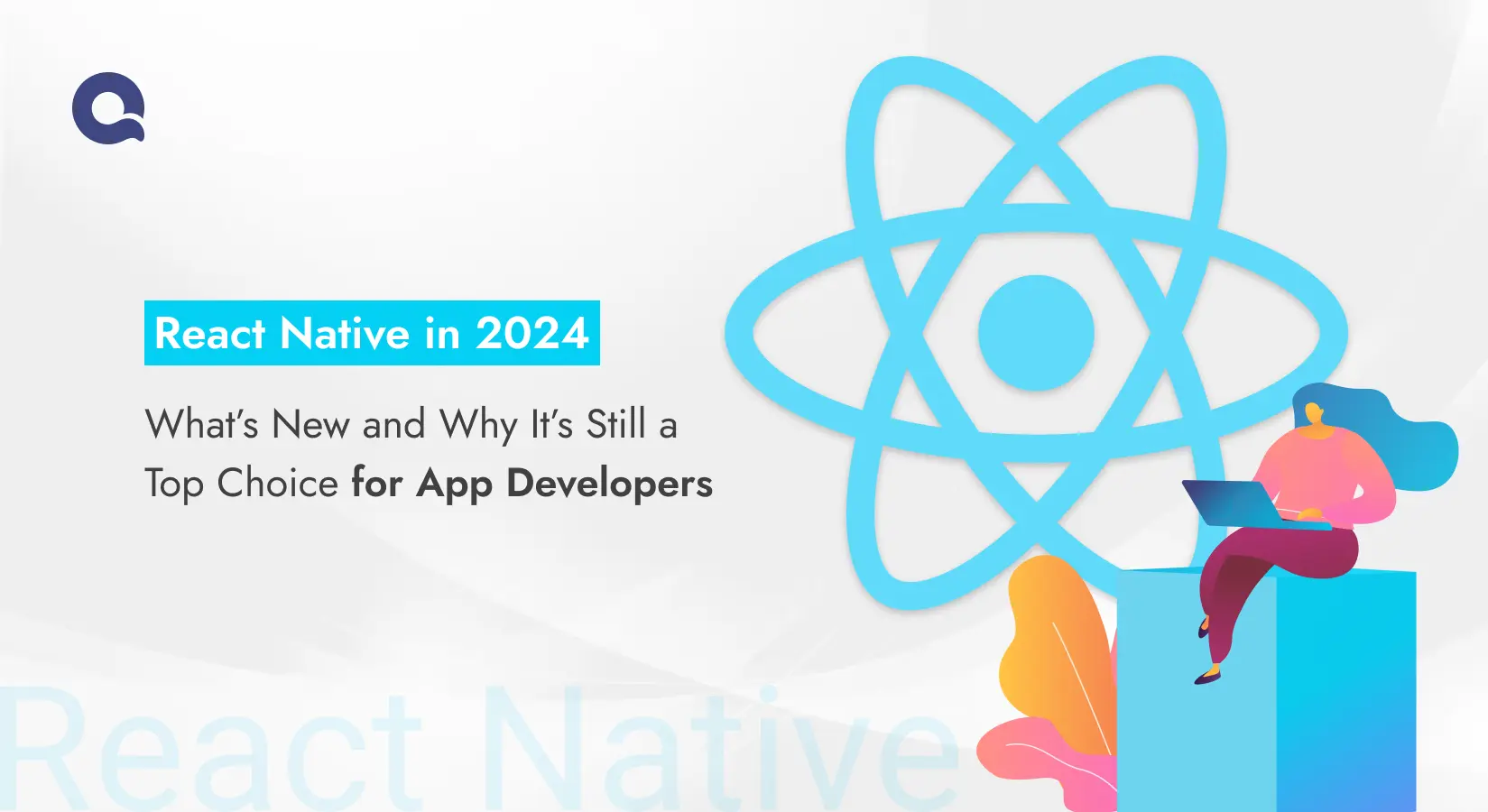
In the fast-paced world of mobile app development, staying ahead of the curve is crucial. React Native, Facebook’s open-source framework has emerged as one of the leading choices for developing mobile applications. As we step into 2024, React Native continues to evolve, incorporating new features and enhancements that make it an attractive option for developers worldwide.
This blog will explore what’s new in React Native for 2024, why it remains a preferred choice for app developers, and how it stands out in the competitive mobile development landscape.
What is React Native?
React Native is a JavaScript framework that allows developers to build mobile applications for iOS and Android using a single codebase. It combines the best of native development with the flexibility of React, allowing for the creation of high-quality, performant mobile apps.
Key Features of React Native:
- Cross-Platform Development: Write once and deploy on multiple platforms.
- Native Performance: Utilizes native components for performance comparable to fully native apps.
- Hot Reloading: Instantly see the results of your code changes.
- Strong Community Support: Backed by a large community of developers and robust resources.
What’s New in React Native for 2024?
As technology evolves, so does React Native. Here are some of the significant updates and improvements for 2024:
1. Enhanced Performance and Stability
A. New Architecture
React Native has adopted a new architecture that improves performance and stability. This architecture utilizes Fabric, a new rendering system, and TurboModules, which enhance the framework’s speed and efficiency.
- Fabric: A new renderer that improves the responsiveness and fluidity of UI components.
- TurboModules: This allows for faster loading times by enabling lazy initialization of modules, which can significantly enhance app performance.
2. Improved Developer Experience
A. New CLI and Better Tooling
The introduction of an updated Command Line Interface (CLI) and improved developer tools makes it easier to manage React Native projects. The new CLI offers better error messages and improved performance, allowing developers to work more efficiently.
- Error Messages: More descriptive error messages help developers quickly identify issues.
- Enhanced Tooling: Tools like Flipper for debugging and performance monitoring have been further improved.
3. Better Integration with Native Features
React Native now offers better access to native device features, allowing developers to create more sophisticated applications that leverage device capabilities.
- New Native Modules: A variety of new native modules are available for accessing device functionalities like the camera, GPS, and sensors.
- Integration with Swift and Kotlin: Easier integration with Swift for iOS and Kotlin for Android enhances the ability to build more complex applications.
4. Updated UI Components
A. Themed UI Components
The addition of themed UI components allows developers to create apps that conform to the latest design trends, improving the overall user experience.
- Customization: Developers can easily customize components to fit their branding needs.
- Consistency: Themed components ensure a consistent look and feel across platforms.
5. New Libraries and Tools
2024 brings several new libraries and tools that simplify common tasks in mobile app development:
- React Native Reanimated 2: A library for creating smooth animations, providing more control and flexibility in crafting animations.
- React Query: A powerful data-fetching library that makes managing server state easier and more efficient.
SUBSCRIBE
Stay updated with our latest news and updates.
Why React Native is Still a Top Choice for App Developers
Despite the emergence of various mobile app development frameworks, React Native continues to be a popular choice. Here’s why:
1. Cross-Platform Compatibility
The ability to write code once and deploy it on both iOS and Android is a game-changer. This significantly reduces development time and costs, making it an attractive option for businesses.
Example: A startup can save resources by hiring one development team to create a single app for both platforms, rather than two separate teams for iOS and Android.
2. Large Community and Ecosystem
React Native boasts a large community of developers who contribute to its continuous improvement. This means access to a wealth of resources, libraries, and third-party plugins that can speed up development.
- Support: A strong community provides answers to common questions and troubleshooting, making it easier for new developers to get started.
- Plugins: The availability of third-party libraries helps extend the functionality of applications without reinventing the wheel.
3. Fast Development and Iteration
The Hot Reloading feature allows developers to see changes in real time without recompiling the entire app. This boosts productivity and allows for faster iteration cycles, essential for today’s agile development environments.
4. Cost-Effectiveness
Cross-platform development and a large pool of available resources make React Native a cost-effective choice for businesses.
- Reduced Development Costs: Companies can allocate resources more efficiently with one codebase and one team.
- Maintenance: Maintaining a single codebase is easier and less expensive than managing multiple codebases.
5. Flexibility and Customization
React Native allows developers to customize components and access native functionalities, enabling the creation of highly interactive and engaging applications.
- Custom Components: Developers can create custom components to meet specific needs, enhancing the user experience.
- Native Modules: Access to device features ensures that applications can leverage the full capabilities of smartphones and tablets.
Real-World Applications Built with React Native
Several high-profile companies and applications utilize React Native, demonstrating its robustness and versatility:
1. Facebook
Being the creator of React Native, Facebook uses it for its mobile app, benefiting from a shared codebase for both Android and iOS, ensuring consistency and faster updates.
2. Instagram
Instagram’s development team leverages React Native for certain features, allowing for rapid iteration and deployment while maintaining the app’s performance.
3. Walmart
Walmart adopted React Native to enhance its mobile shopping app experience. By using React Native, Walmart has improved performance and user engagement.
Future of React Native: What Lies Ahead?
As we look ahead, the future of React Native appears promising. With continuous updates and a strong community, we can expect:
1. Increased Adoption in Enterprises
More enterprises will adopt React Native for their mobile app development needs, given its cost-effectiveness and the ability to maintain a single codebase.
2. Expanded Libraries and Tools
The ecosystem around React Native is likely to grow, providing developers with even more tools and libraries that enhance productivity and functionality.
3. Focus on Performance
React Native will continue to prioritize performance enhancements, ensuring that apps built on the framework can handle the increasing demands of users and technologies.
📚 Further Reading
Conclusion
React Native continues to evolve and adapt to the changing needs of app developers in 2024. With significant updates that enhance performance, streamline development, and provide better integration with native features, it remains a top choice for businesses looking to create high-quality mobile applications.
As technology progresses, React Native is well-positioned to meet the challenges of modern app development, making it an excellent option for developers and businesses alike. If you’re considering building a mobile app, contact QalbIT Infotech PVT LTD for expert assistance in React Native development. Let us help you bring your app idea to life!
SUBSCRIBE
Stay updated with our latest news and updates.
Frequently asked questions
React Native is an open-source framework developed by Facebook that allows developers to create mobile applications for iOS and Android using JavaScript and a single codebase.
Key benefits include cross-platform compatibility, a large developer community, faster development and iteration through Hot Reloading, cost-effectiveness, and flexibility in customizing UI components.
While native app development allows for complete access to platform-specific APIs, React Native enables faster development and maintenance by using a single codebase for both platforms, making it a more cost-effective solution for many projects.
We can expect ongoing enhancements in performance, increased enterprise adoption, and a growing ecosystem of libraries and tools that improve developer productivity and application functionality.







